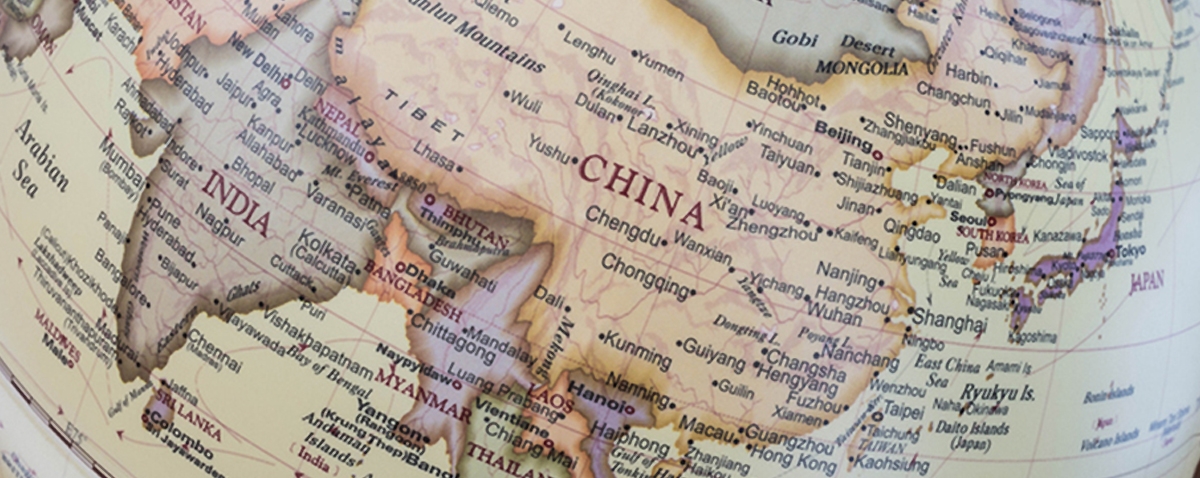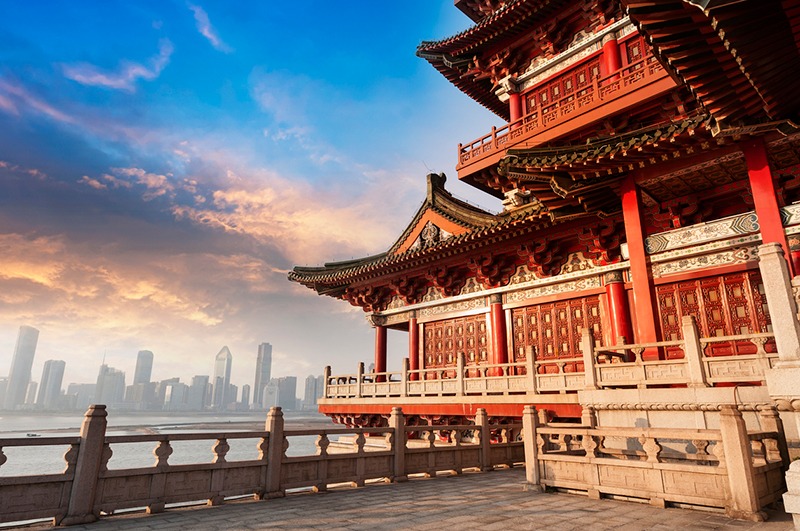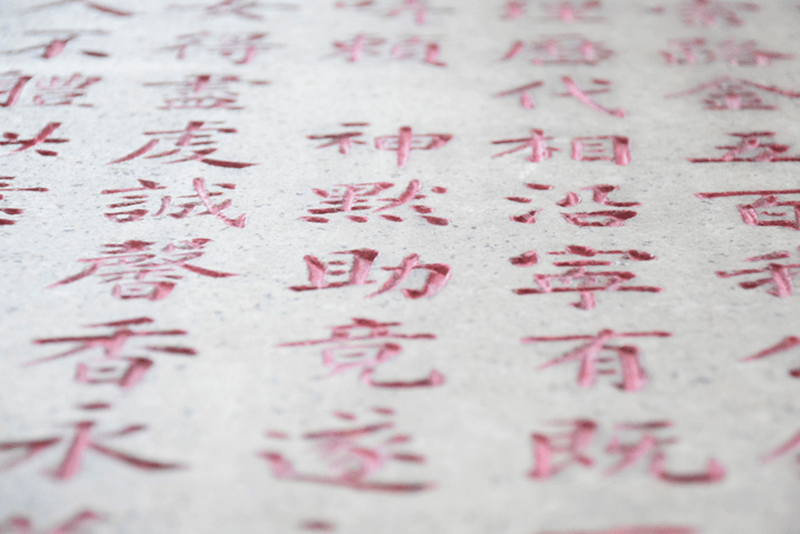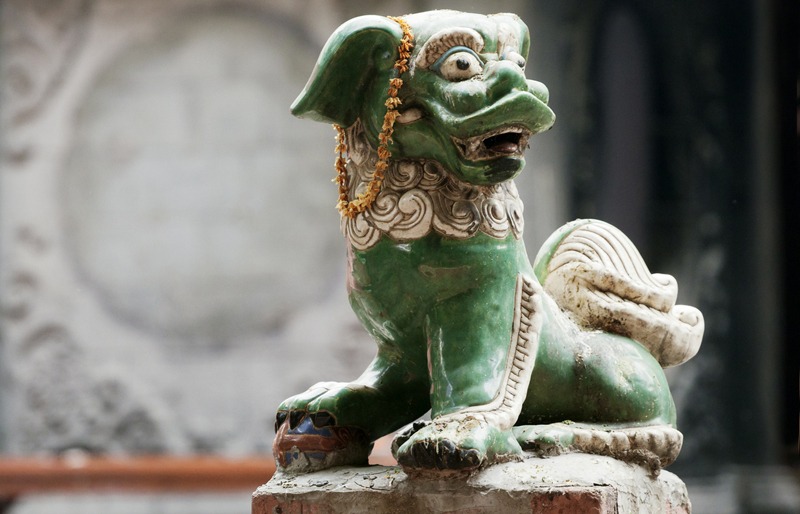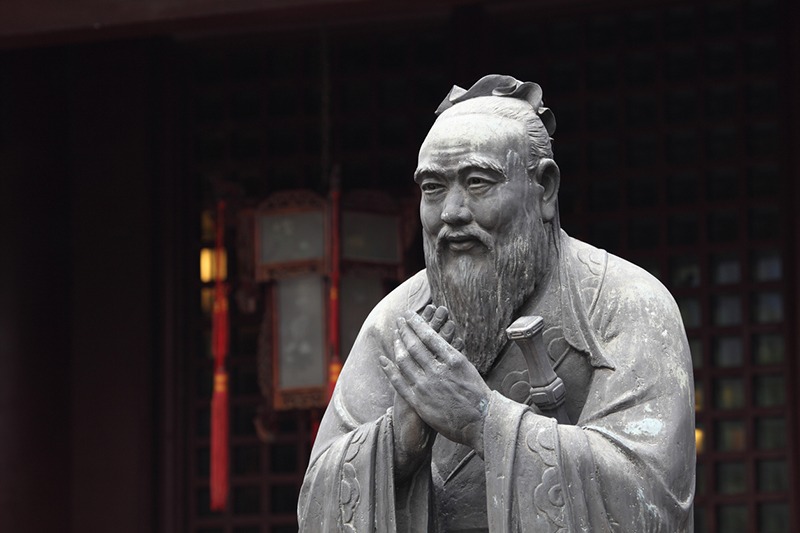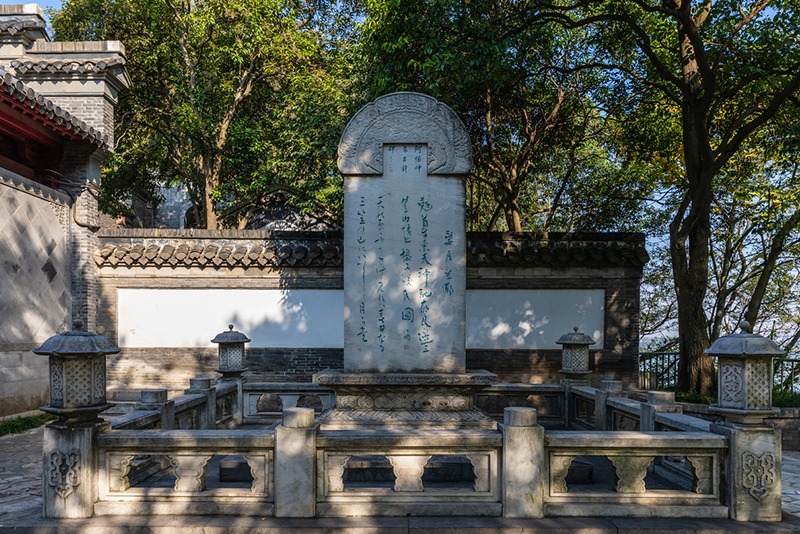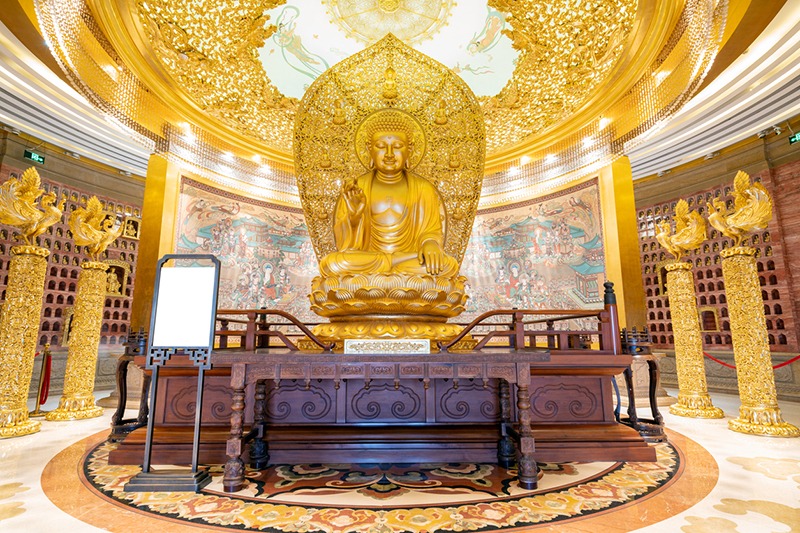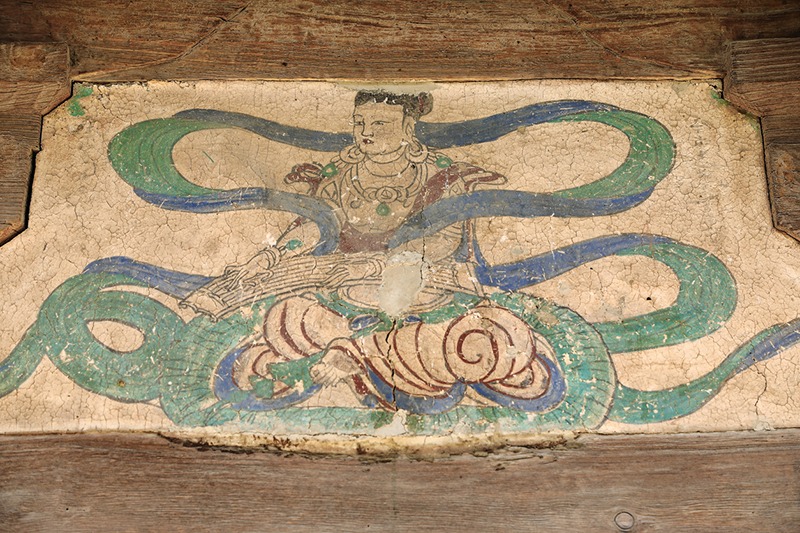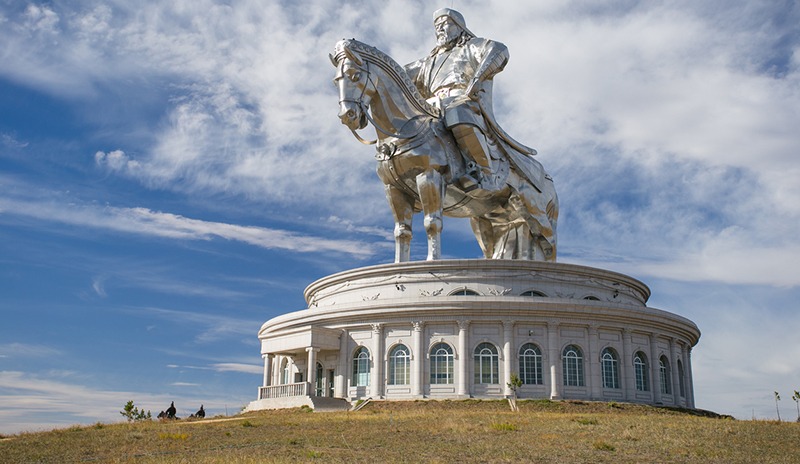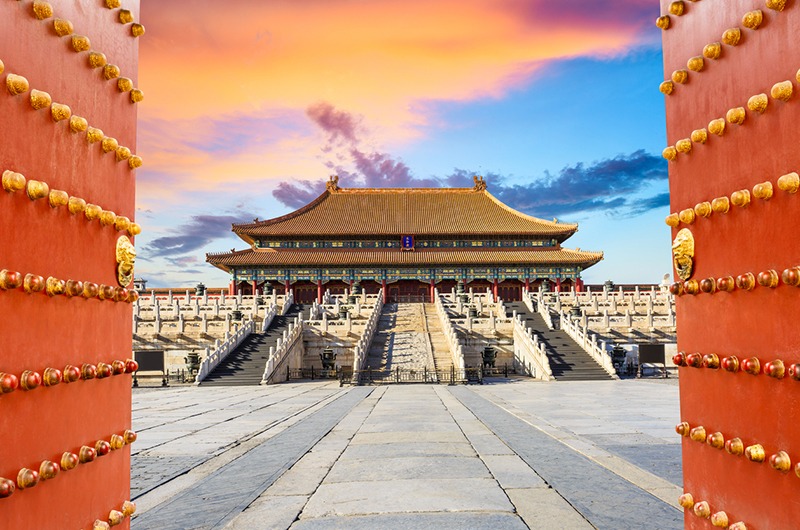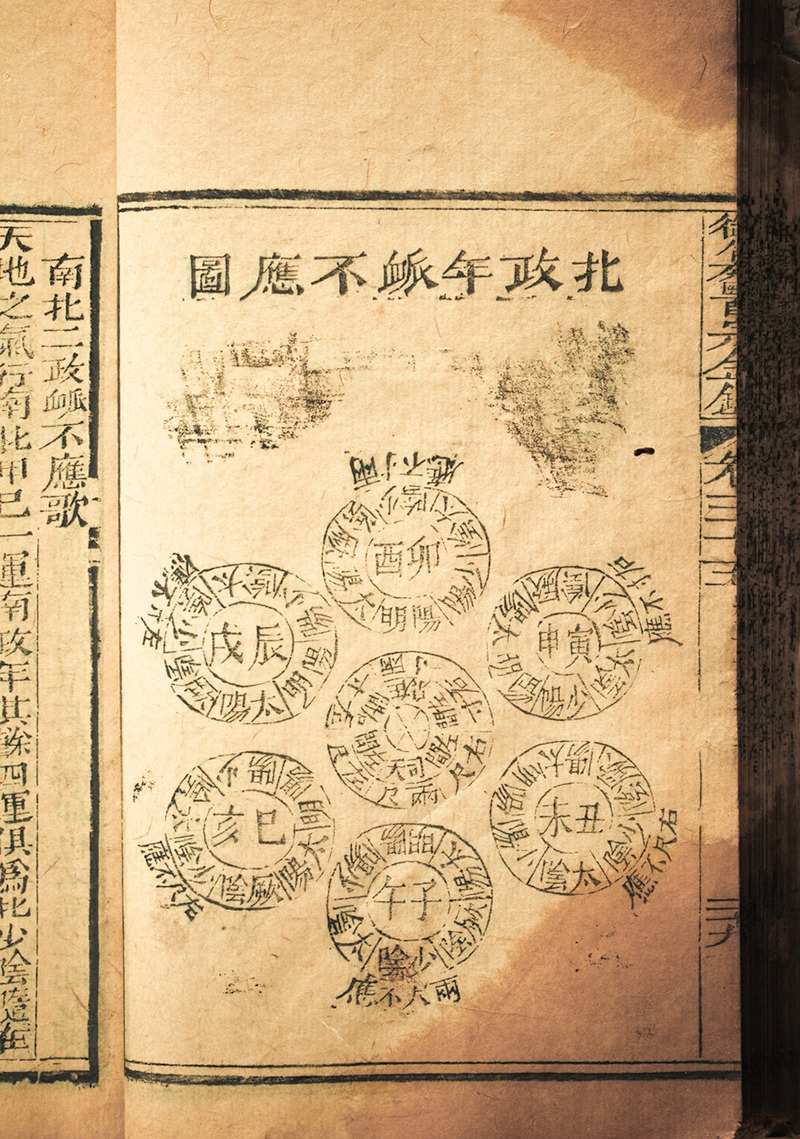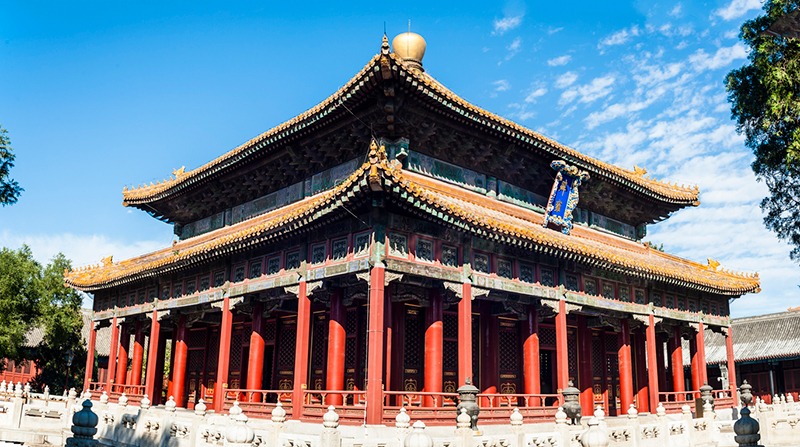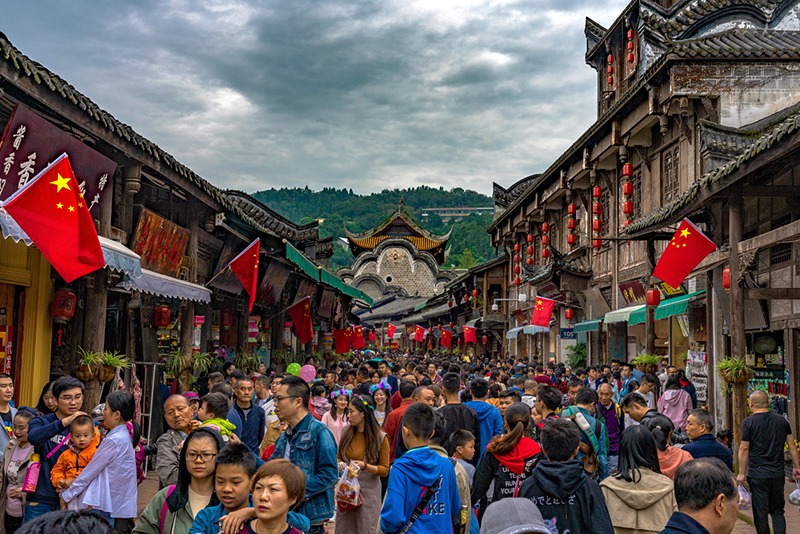Table of Contents
The Chinese empire is among the world’s most resilient historical empires. Various dynasties—family groups that governed the empire—rose and fell throughout its long history. A dynasty is a period during which a certain family dominated. [1]
Single dynastic families frequently ruled for hundreds of years until being deposed by another great dynasty. The throne was passed down through the generations from father to son.
From the legendary beginnings of the Chinese dynasties to the final demise of the last imperial house, Chinese emperors have fought for control of one of the world’s most lasting empires. Waves of innovation and cultural advancement were witnessed when successive imperial lineages rose and fell.
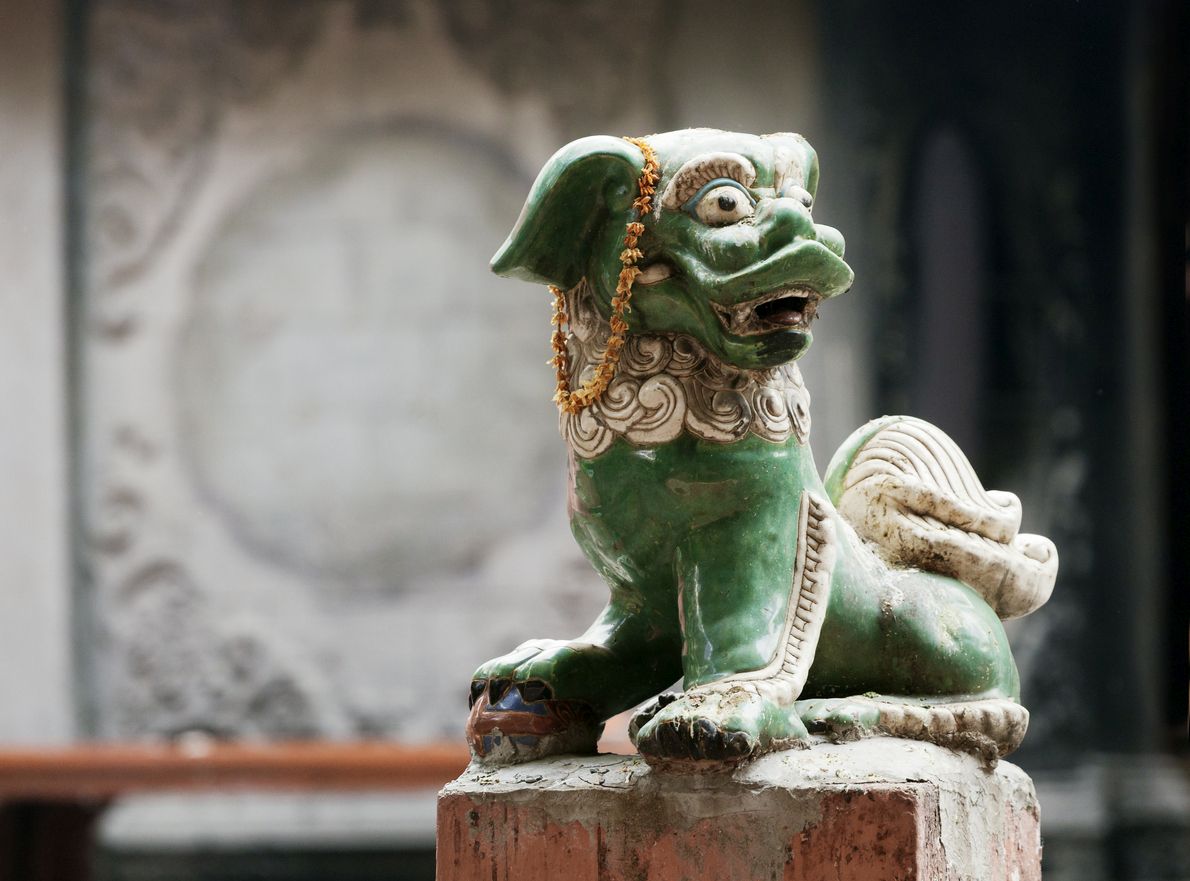
ancient jade
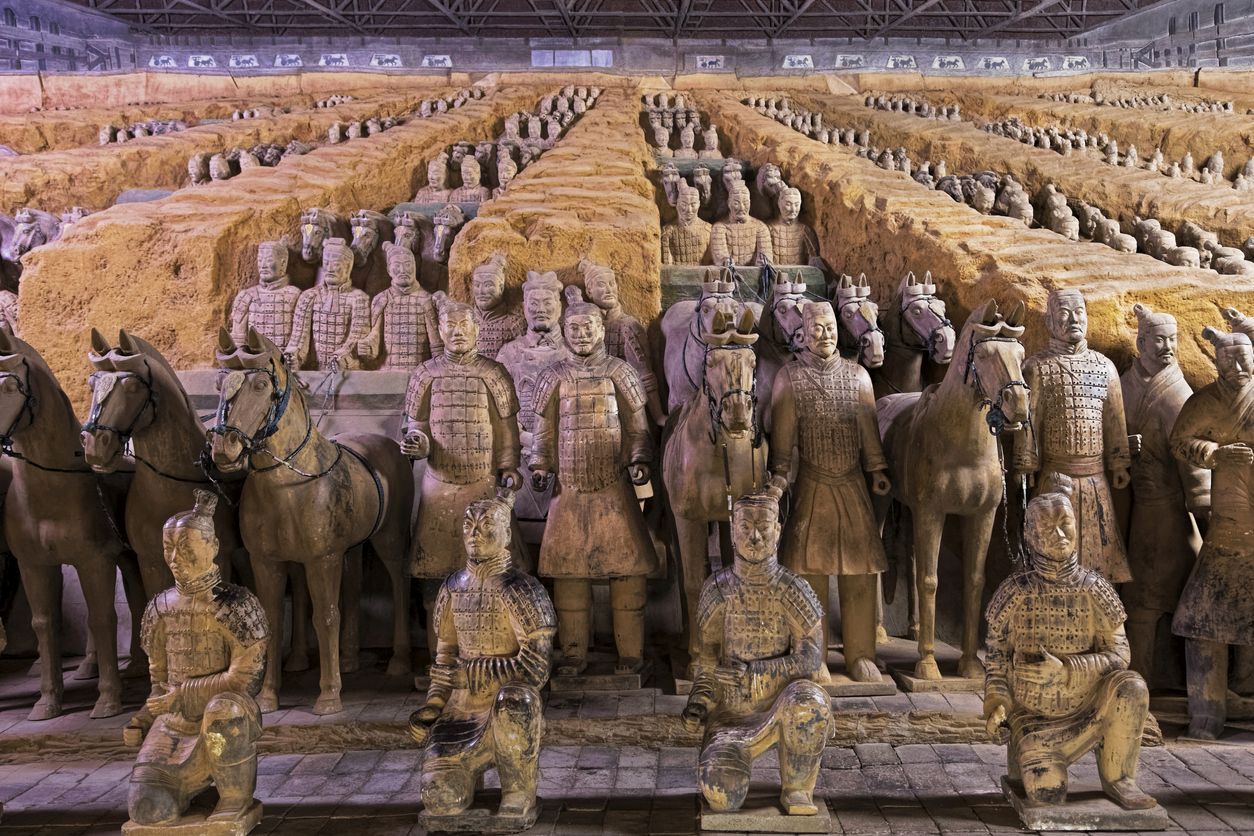
Terra Cotta Warriors, archeological site in Xi’an China
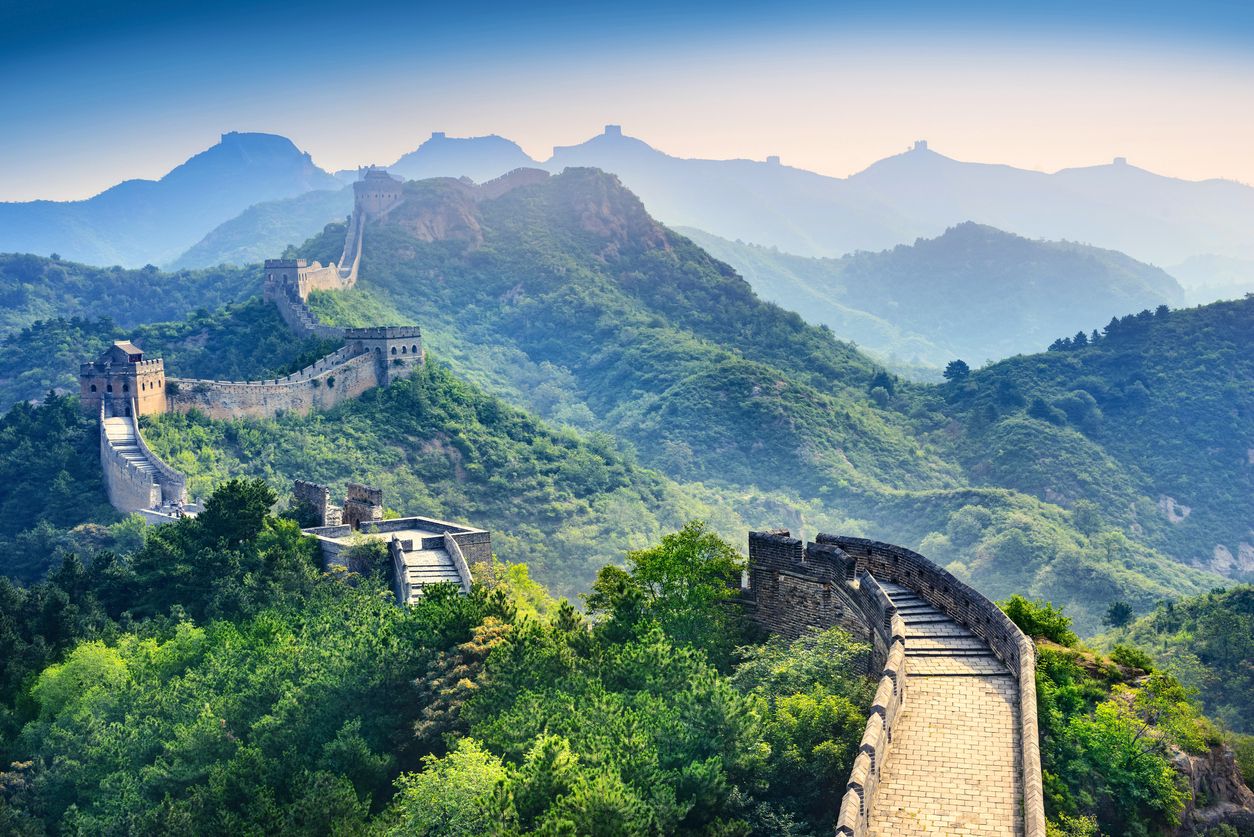
The Great Wall of China

Buddha Statue and a sunset background
The 13 Dynasties that Ruled China
The history of China is often organized by the dynasty to which the ancient emperors belonged at the time. Since its inception, China was controlled by a succession of 13 dynasties from 2070 BC to the abdication of its last ruler in 1912. [2]
1. Xia Dynasty (c. 2070-1600 BC)
The first Chinese dynasty was the Xia dynasty. It was founded by Yu the Great (c. 2123-2025 BC), a legendary king credited with inventing a flood-control method that prevented the Great Flood from destroying farmers’ crops for years.
Little is known about the Xia period because there is a severe scarcity of written evidence for this dynasty. Most academics assume that stories about it were told rather than written down. We don’t see written records of this first Chinese dynasty until the Zhou Dynasty, 554 years later. As a result, some historians consider it mythical or quasi-legendary.
2. Shang Dynasty (c. 1600-1050 BC)
The Shang dynasty is the first Chinese dynasty to be documented and substantiated by archaeological evidence. Much of the land along the Yellow River was governed by 31 rulers.
Math, art, astronomy, and military technology advanced under the Shang dynasty. They employed a sophisticated calendar system and an early form of the contemporary Chinese language.
3. Zhou Dynasty (c. 1046-256 BC)
The Zhou dynasty ruled China for about eight centuries, making it its longest dynasty.
Culture flourished, and civilization spread under the Zhous. Chopsticks were invented, writing was standardized, and the currency was formed.
Taoism, Confucianism, and Mohism were among the first philosophical schools to emerge in China. The dynasty produced some of China’s greatest thinkers and poets, including Lao-Tzu, Confucius, Tao Chien, Mo Ti, Mencius, and Sun-Tzu, the military strategist.
4. Qin Dynasty (221-206 BC)
The Qin dynasty established the start of the Chinese Empire. China was substantially enlarged during Qin Shi Huangdi’s reign to include the Ye regions of Hunan and Guangdong.
The period featured grandiose public works projects such as merging state walls into a single Great Wall; however, it was short-lived. It saw the creation of a standardized form of currency, a standardized writing system, and a legal code.
5. Han Dynasty (206 BCE-220 AD)
In Chinese history, the Han dynasty was known as a golden age, with a long period of prosperity and stability. A central imperial civil service was established to develop a strong, well-organized government.
China’s territory was expanded to include the majority of the country. The Silk Road was established to connect the east and west, bringing other cultures, trade, and Buddhism.
Confucianism, poetry, and literature flourished under the Han dynasty. There was the invention of paper and porcelain. The Yellow Emperor’s Canon of Medicine, China’s first written record on medicine, was codified.
6. Six Dynasties Period (220-589)
During this tumultuous time, “six dynasties” refers to the six consecutive Han-ruled dynasties. All of them had capitals in Jianye, which is now Nanjing.
The Three Kingdoms period has been romanticized in Chinese culture, most notably in the novel Romance of the Three Kingdoms.
7. Sui Dynasty (581-618)
Although brief, the Sui dynasty saw significant developments in Chinese history. Its capital was Daxing, which is now Xi’an.
Confucianism fell out of favor as the major religion, with Taoism and Buddhism taking its place. Literature flourished during this time, and the legend of Hua Mulan was believed to be written during this period.
Emperor Wen and his son, Yang, expanded the army to become the world’s largest at the time. The Great Wall was expanded, the Grand Canal was built, and coinage was standardized across the realm.
8. Tang Dynasty (618-906)
The Tang dynasty is considered the pinnacle of Chinese civilization, known as the Golden Age of Ancient China. Taizong, the country’s second emperor, was recognized as one of China’s greatest emperors.
One of the most tranquil and affluent periods in Chinese history occurred. China was the world’s largest and most populous country when Emperor Xuanzong (712-756) ruled.
Technology, culture, art, science, literature, and poetry all saw significant advancements. The Tang dynasty is responsible for some of China’s finest magnificent art and silverwork.
9. Five Dynasties Period, Ten Kingdoms (907-960)
Internal strife and chaos dominated the 50 years between the Tang dynasty’s demise and the founding of the Song dynasty.
Five would-be dynasties in north China succeeded one another in turn. Ten different regimes ruled different parts of south China during the same period.
10. Song Dynasty (960-1279)
Emperor Taizu oversaw the reunification of China during the Song dynasty. Major inventions during this time were gunpowder, paper money, printing, and the compass.
The Song court, plagued by political conflicts, eventually succumbed to the Mongol invasion and was replaced by the Yuan dynasty.
11. Yuan Dynasty (1279-1368)
The Mongols established the Yuan dynasty, controlled by Kublai Khan (1260-1279), Genghis Khan’s grandson. Khan was the first non-Chinese king to dominate the country as a whole.
The huge Mongol Empire stretched from the Caspian Sea to the Korean peninsula and considered Yuan China the most significant section.
12. Ming Dynasty (1368-1644)
During the Ming dynasty, China’s population and general economic prosperity exploded. However, the Ming monarchs faced the same issues as past dynasties and fell victim to the Manchu invasion.
The Great Wall of China was completely built during this period. The Forbidden City, Beijing’s imperial residence, was also built during this period. Ming porcelains in blue and white are also popular during this time.
13. Qing Dynasty (1644-1912)
In 1912, the Republic of China succeeded the Qing dynasty as China’s final imperial monarchy. The Qing dynasty was made up of ethnic Manchus from Manchuria in northern China.
The Qing dynasty was the world’s fifth-largest empire. By the early twentieth century, aggressive foreign powers, rural instability, and military weakness had weakened its authorities.
The Timeline of Chinese Dynasties [3]
Years | Dynasty | Area | Significant Event/s and Capitals |
ca. 2100-1600 BCE | Xia (Hsia) Dynasty | Data not available | |
ca. 1600-1050 BCE | Shang Dynasty | 1,250,000 km² (480,000 sq mi) [10] | Capitals: near present-day Zhengzhou and Anyang |
1046-256 BCE | Zhou Dynasty | Data not available | ● Capitals: Hao (near present-day Xi'an) and Luoyang |
221-206 BCE | Qin Dynasty | 2,300,000 km² (890,000 sq mi) [11] | ● Capital: Chang'an, present-day Xian |
206 BCE-220 CE | Han Dynasty | ● Western Han peak - 6,000,000 km² (2,300,000 sq mi) [11] | ● Capital: Chang'an (present-day Xian) |
220-589 CE | ● Six Dynasties Period | ● Western Jin peak - 3,100,000 km² (1,200,000 sq mi) [11] | ● Period of disunity and instability following the fall of the Han |
581-618 CE | Sui Dynasty | 3,000,000 km² (1,200,000 sq mi) [11] | Capital: Chang'an (present-day Xian) |
618-906 CE | Tang Dynasty | 5,400,000 km² (2,100,000 sq mi) [10] | Capitals: Chang'an (present-day Xian) and Luoyang |
907-960 CE | Five Dynasties Period | Data not available | |
960-1279 | Song (Sung) Dynasty | 1,800,000 km² (690,000 sq mi) [12] | ● Capital: Bianjing (present-day Kaifeng) (960-1127) |
1279-1368 | Yuan Dynasty | 11,000,000 km² (4,200,000 sq mi) [12] | ● The reign of the Mongol empire |
1368-1644 | Ming Dynasty | 6,500,000 km² (2,500,000 sq mi) [12] | ● Re-establishment of rule by Han ruling house |
1644-1912 | Qing (Ch'ing) Dynasty | 13,400,000 km² (5,200,000 sq mi) [12] | ● Reign of the Manchus |
Start of Dynastic Rule
Yu the Great is often considered the founder of China’s first orthodox dynasty, the Xia dynasty, and hence the forerunner of dynastic power in China. Sovereign kings had theoretically absolute power and private ownership of the realm in the Chinese dynastic system, but their actual power was based on many variables.
The Chinese monarchy was traditionally only passed down through the male line, although there were multiple instances where the consort kins gained de facto power at the expense of the monarchs. This concept, identified as jiā tiānxià (家天下, meaning “All under Heaven belongs to the ruling family”), contrasted with the pre-Xia view of gōng tiānxià (公天下, meaning “All under Heaven belongs to the public”), which allowed for non-hereditary leadership succession. [4]
The Xia Dynasty
The Xia Dynasty (2070–1600 BC) was China’s first known dynasty; however, its existence and records are contested. However, most Chinese people believe that their ancestors came from the area around Tianjin and Beijing and the Yellow River on China’s east coast.
This empire was claimed to have lasted roughly 400 years before being conquered by the Shang Dynasty in 1600. We understand what early civilization was like based on historical records or myths that are at least 2,000 years old. [5]
Xia’s Origins – Descendants of a Great Emperor
According to the Records of the Grand Historian, there were clan fights before Xia was founded. Xia was a descendent clan of Zhuanxu. In ancient times, Zhuanxu was one of the five great emperors.
The Xia Dynasty Was Founded by Yu the Great (reign: 2029–1978 BC)
Shun, the monarch of the Xia clan at the time, admired Yu the Great. The Xia tribe beat a neighboring tribe as their strength expanded. Shun ordered Yu to subjugate the Sanmiao tribe, successfully allowing the Xia clan to grow stronger.
The Xia Dynasty began when Shun surrendered his throne to Yu the Great.
Before the Xia Dynasty, the clans transferred their kingship to a trustworthy individual. On the other hand, Yu the Great gave his son Qi his throne. Then came the dynastic system.
Another legend claims that Yu the Great intended to bequeath the throne to Gaotao, but Gaotao died first. He intended to pass it on to Boyi after that, but his son Qi had a better reputation than Boyi. As a result, Qi assassinated Boyi and ascended to the king.
Yu the Great’s Tales of Taming Yellow River Floods
According to legends, a big flood in 2215 BC lasted for several years. A wise monarch named Yao (2358–2258 BC) tasked a man named Yu the Great with controlling the flooding of the Yellow River.
The dates of these alleged occurrences do not really match. It is believed that Yao told Yu’s father, Gun, to keep the flood under control.
However, the dikes he constructed to prevent flooding were ineffective. They gave way, and the region became flooded. As a result, Yao assassinated Gun and recruited Yu. Yu developed canals to divert the water rather than depending on dikes. Digging the canals necessitated the removal of a mountain. Yu’s Doorway (禹门口) was the location where the mountain was demolished.
The flood relief efforts brought the people living along the Yellow River together. Yu the Great earned a good reputation by taming the flood with the help of other clans.
The Xia tribe grew stronger as a result of increased crops. People admired Yu for successfully controlling the water, and he went on to become the Xia clan’s emperor.
The Story of the Xia Dynasty’s Demise (1559 BC)
Hundreds of years are said to have passed since the Xia Dynasty began. During the reigns of the other 17 emperors, the kingdom saw ups and downs, and it expanded.
The Xia Empire Lost Prestige and Fell Out with Other Clans
One of the emperors, Kongjia, transformed the traditional practice of honoring ancestors to honoring supernatural creatures. Xia’s rule was unpopular with several clans. When Jie ascended to the throne, the good connections between Xia and the other clans were shattered.
Jie, the Last Xia Emperor (1590–1559 BC)
The last emperor, Jie, was wasteful and squandered his wealth. Jie built a palace for his favorite concubine and drank till the wee hours of the morning. He assassinated his faithful ministers who dared to criticize him.
Emperor Jie adored ladies, and when he repressed a clan, he took the women he desired with him. The Shang clan grew stronger when Xia fell out of favor with the other clans. Jie then ended Shang’s rebellion and imprisoned Tang, their leader, but he was eventually released.
Emperor Jie’s rash rule is claimed to have caused the dynasty to lose favor with Heaven, i.e., The Mandate of Heaven had been lost by Xia, and it was doomed to be replaced.
Other Clans Followed the Shang Clan’s Lead to Depose Xia
Tang of Shang successfully joined the other clans to suppress Jie around 1559 BC. Tang became the Shang Dynasty’s first leader after Jie was exiled.
The First Historical Dynasty: The Shang
From 1600 BC until 1046 BC, the Shang Dynasty ruled over northeastern China in the Yellow River valley. Though these are only estimates, many archaeological finds (oracle bones, bronzes, and tortoise shells) point to the formation of this dynasty, which was formed by the commander Shang Tang, who conquered Mingtiao, the final emperor of the Xia Dynasty.
The Shang Dynasty’s discoveries aid in understanding these populations’ (possibly descendants of Neolithic Longshan culture settling in the Yellow River valley) political, religious, economic, and cultural history.
The writings on bones, tortoise shells, and funerary bronzes discovered in the royal family’s tombs, reveal that the dynasty had advanced to a high degree of civilization.
In truth, the Shang dynasty created a complicated writing system, was skilled in bronze casting, and produced many pottery vessels. Copper, tin, and lead were mined, transported, and refined by the inhabitants. In addition, during this time, jade artifacts for religious ceremonies and silk were being developed.
The Shang empire was more than a dynasty; it was a confederation of tribes and fiefdoms unified by the Shang rulers’ religious and military might, constituting the basis of future dynasties.
The Zhou and Qin Dynasties
The Zhou Dynasty
Many monarchs ruled throughout the Zhou Dynasty (1045-256 BC), which was divided into two periods: Western Zhou (1045-771 BC) with capital Zhongzhou/Hao, near present-day Xi’an, Shaanxi; and Eastern Zhou (770-256 BC) with capital in Luoyang, Henan.
After defeating the final Shang ruler Di Xin in the Battle of Muye, King Wu established the Zhou Dynasty, which pushed out the nomads of the north and expanded its territory through military operations.
The Zhou consolidated their authority through a feudal system based on local city-states and officials who frequently met to make crucial decisions.
The “Annals of Spring and Autumn,” generally credited to Confucius, chronicle events from the 7th to the 4th centuries, with periods of relative calm and prosperity interspersed by internal feuds amongst lords. The fifth century BC was known as “the Warring Nations Period,” when four of the most powerful states fought for dominance.
Hydraulic engineering, agriculture, and bronze work for military and civilian reasons are all further developed with the highest standards of artistry throughout the Zhou Dynasty. When jades and bronzes lost their religious significance, they became symbols of power.
The employment of molds and stamped ornamentation towards the end of Zhou’s work suggests a high level of quality control. Bronze vessels for funerary usage come in various shapes and ornamental styles.
The Zhou dynasty came to an end with the surrender of Kaifeng’s capital, Wei (225 BC), and the fall of Chu (223 BC), Yan, and Zhao (222 BC), ushering in the Qin Dynasty.
Transition From the Zhou to the Qin Dynasties
The State of Qin captured the last warring states in 221 BC, bringing China together under the Qin Dynasty. Xi’an became the First Emperor’s new capital. He was known for massive construction projects such as his mausoleum with Terracotta Warriors and the first finished Great Wall. [6]
The Qin Dynasty
In 221 BC, the Qin Dynasty’s first emperor, Qin Shi Huang, emerged after a three-century turbulence (Period of Spring and Autumn) and in-fighting within China’s four main kingdoms (Warring States).
The Qin unified the Middle Kingdom by establishing a central government that supported the feudal system, standardizing the Chinese language, constructing a network of major roads and public transportation to facilitate the vast military empire’s movements, and reforming the weights, currency, and measures.
The Qin Dynasty lasted barely 15 years, yet during that time, great works such as the Great Wall’s foundations and the tomb of Qin Shi Huang, the recently discovered legendary Terracotta Army in Lintong, near the capital Xianyang, Xi’an, Shaanxi province, were completed.
The Qin dynasty also encouraged the growth of the pottery industry, but the aforementioned 6,000 life-size terracotta horses and soldiers, buried in the tomb of Qin Shi Huang to guard the emperor are the dynasty’s masterpiece.
The Han Dynasty
Liu Bang, also known as the Han Sovereign Emperor, founded the Han dynasty and ruled it for four centuries, from 206 BC until 220 AD, spreading its power to Korea, Vietnam, and Central Asia. The Xin Dynasty, which is considered the first of China’s most important dynasties (Wang Mang Period, 9-23 AD), briefly interrupted it. The Han dynasty is frequently divided into two parts. The Western Han (206 BC – 9 AD) with Chang’an as its capital, and the Eastern Han (25 AD – 220 AD) with Luoyang as its capital.
This was a time of economic prosperity, political centralization, and military conquest. They also saw significant intellectual, artistic, cultural, and scientific breakthroughs, making it one of China’s greatest dynasties.
Emperors fostered the development of Buddhism, Confucianism, and Taoism to maintain peace and prosperity. Instead of silk, the paper was found, refined, and utilized as a foundation in Scripture.
The Han substantially improved silk weaving skills, which provided vast economic space along the Silk Road that eventually reached the Roman Empire thanks to relationships with foreign nations. Silk and precious stones from China were traded, while glass, silver ivory, and incense returned from the Roman Empire.
The Han Dynasty is also known for its manufacturing of ceramics for both home and commercial usage, with seals featuring the names of government offices or furnace locations, implying a widespread industry. There’s an uptick in manufacturing hard pottery with etched designs and the first appearance of green or yellow-glazed pottery.
Celadon of good quality is produced near the conclusion of the dynasty, with an iron content of lower than 2%. Even technological improvements like copper and lead are there, but the containers are only used for mortuary and funeral purposes, not everyday use.
The Six Dynasties
The fall of the Han dynasty ushers in the first period of Chinese disunity, with three emperors claiming power after Han’s demise in 220 AD.
It included six Chinese dynasties and kingdoms, wars, diseases, and political unrest that marked this long period, which ended with the Sui Dynasty’s arrival in 581.
The Three Kingdoms period (220-280), the Jin Dynasty (265-420), and the Southern and Northern Dynasties (420-589), with Jiankang (today’s Nanjing) as its capital, comprise the Six Dynasties.
Confucianism’s traditional ideas are abandoned to make room for Buddhism and Taoism.
Despite political and territorial unrest, art, sculpture, poetry, and painting continue to grow, particularly after the invention of printing, which disperses Buddhist principles to the public. Even calligraphy takes on new artistic forms.
The Sui Dynasty
After more than three centuries of division and intense political conflicts, the Sui Dynasty took control of China (581-618), with Wendi Yang Jian, the creator, and visionary who consolidated the Chinese empire. After the fall of the third emperor, it survived only 37 years, having been defeated in multiple battles with surrounding northern states and beset by internal rebellions.
During this time, Buddhism made a significant contribution, being introduced to China during the Han Dynasty and progressively recognized and fostered by the Sui imperial family. It established a unified cultural force that helped the population recover from the conflict.
Buddhism was important for the resurgence of Chinese culture during the Sui Dynasty.
Another notable contributor to economic expansion was the excavation of the Imperial Canal (nearly 1000 miles), an artificial river that united the capital Chang’an (Daxing) and Luoyang, creating a network of waterways for transit, trade, and military uses. Other undertakings, like the Great Wall’s restoration and the currency’s reunification, boosted the empire’s growth and paved the way for the Tang Dynasty to come.
Another discovery in this period, influenced by India, is the introduction of white polychrome and ceramic pottery earthenware, which may be found in the sculptures of Buddhist temples and caves.
The Tang Dynasty
The Tang Dynasty, established by the Li family and ruled for about three centuries (618-907 AD), was shortly halted by the Second Zhou Dynasty (690-705). This dynasty, which had its capital in Chang’an (modern-day Xi’an), is generally referred to as the pinnacle of Chinese culture, a period of peace and prosperity secured by soldiers ready to defend the empire’s boundaries, which promoted the flowering of cultural productions.
Chang’an, the capital, was a magnificent metropolis that drew diplomats from all over the world. It was the “Middle Kingdom” of China.
Confucianism made a comeback, with Confucianism being taught in schools and expected of all public officials.
The earliest missionaries started to preach Nestorian Christianity, erecting churches and temples and interpreting sacred writings. Buddhism grew due to trade with India, albeit it declined towards the end of the ninth century.
The Silk Road, now safer and more popular, becomes an economic resource for the entire empire, bringing new technologies and cultural lifestyles from India, the Middle East, and Persia to the Tang Dynasty, including new ideas about dresses, new types of ceramics (ceramics sancai-covered with lead, tricolor figurines tombs, cobalt blue enamels), and the development of silverware.
The form of the dragon is replaced in the graves of the nobility by sculptures of horses and camels (power emblems), along with gold and silver embellishments. Painters, poets, and writers of historical and geographical encyclopedias from this period are well-known. There is a rise in mass-market woodblock printing and flourishing art and culture.
In Chang’an, the mighty capital, there is also a high level of religious tolerance, with Buddhism promoting a wide range of sculptural and painted art. Painting achieves high levels of aesthetic quality throughout the Tang dynasty, owing to its landscapes. Even statues are highly artistic, as indicated by the shrine guardians (marked with musculature), the Buddha statue in Longmen caves (Henan), and figurines of dancers, court ladies, or music players, all of which are highly valued for their grace.
The Tang dynasty’s golden age came to an end due to several factors, including floods in the Imperial Canal (858) that killed thousands of people, a disastrous drought and famine in 873, and revolts led by General Zhu Wen (founder of the Liang Dynasty, the first of the Five Dynasties) at the early 9th century. The Tang emperors’ central control was undermined due to these occurrences.
The Five Dynasties and the Ten Kingdoms
The Tang dynasty’s demise was succeeded by 53 years of disunity known as the “Period of Five Dynasties and Ten Kingdoms,” which allowed the Song Dynasty to reunify the kingdom in 960.
The north was ruled by five dynasties (Later Liang, Later Jin, Later Tang, Later Zhou, Later Han), whereas over ten kingdoms ruled the south.
The invention of “white ceramics” was a time of development in ceramic technology, albeit short.
The painting also offered China’s “varied landscape,” inspired by Taoism, with ink strokes portraying the sanctity of the mountains, regions between heaven and earth, and depicting the natural world as a source of peace.
The Song Dynasty
Following the Han and Tang dynasties, the Song Dynasty is regarded as China’s third golden age, with significant advances in philosophy, literature, and science. Although his kingdom was divided into two periods, the Northern Song (960-1127) with the capital Kaifeng and the Southern Song (1127-1279) with the capital Lin’an (present-day Hangzhou), Kuangyin Zhao united China’s central plains and southern areas, forming the Song dynasty in 960.
The Song Dynasty took China’s economy to its pinnacle of wealth, transitioning from agriculture to trade. The government gave peasants land ownership, the merchant class flourished, and printing, the magnetic compass, and gunpowder were all discovered in the realm of technology. Papermaking, silk production, the advent of the cotton textile industry, and the art of porcelain making all grew in popularity.
The development of printing and freedom of expression created an excellent atmosphere for writers, intellectuals, and painters to present their work outside the empire. However, it was also a time marked by the cruelty of northern invaders (Jurchen, Liao Dynasty), who captured the capital Kaifeng in 1127, forcing the inhabitants to relocate to the south and build the new capital Lin’an (Hangzhou).
The Song’s paintings vividly depict the sorrowful history of forced migration.
Ceramics throughout the Song dynasty advanced in both business and technology, achieving very high levels of art in the glaze, cooking process, decoration, and overall appearance. Ge, Jun, Guan, Ru, and Ding (the “five famous imperial kilns”) sold porcelain to the Philippines, Thailand, Indonesia, Europe, India, Japan, and Egypt.
The Southern Song Dynasty was overthrown by Kublai Khan, grandson of Genghis Khan, in 1279, bringing an end to China’s pinnacle period, which was marked by philosophy, political centralization, art, and economic expansion.
The Yuan or Mongol Dynasty
Kublai Khan, a Mongol king, established the Yuan Dynasty (1271-1368) and became the first Emperor of China who was not of Han heritage. He picked Dadu (today’s Beijing) as its capital, overcoming the Southern Song’s last resistance and establishing the “Great Yuan Empire.”
The Yuan Dynasty fostered trade with other states such as the Middle East, India, and Europe in such a huge territory, contributing to the empire’s cultural variety. Marco Polo, the most famous foreigner of the time, admired Chinese traditions for 17 years.
Kublai Khan was educated in Chinese history and philosophy, and from the beginning of his rule, he followed many of the customs of past Chinese dynasties, such as political administration and the usage of Han names. Given the scarcity of copper, the Yuan Dynasty was the first to rely nearly entirely on banknotes. Regarding politics and administration, Kublai Khan sought guidance from a Han council, encouraged religion and science, backed the Silk Road market, and issued a letter to the Pope in Latin requesting the dispatch of Christian missionaries to China.
Buddhism (Tibetan) and Confucianism flourished during the Yuan Dynasty, but Taoism was persecuted.
There was a development of poetic formwork and landscape painting in the arts (birds and flowers). Craftsmanship and agriculture, the foundations of Chinese civilization’s economy, suffered tremendously due to the Mongol empire’s overbearing military presence. On the other hand, the Yuan Dynasty’s pottery was shipped in huge quantities to far-flung locales, including Northern Africa.
In 1368, Zhu Yuanzhang seized Beijing, driving the Mongols out of China’s Central Plains and establishing the Ming Dynasty.
The Ming Dynasty
The Ming Dynasty (1368-1644) was the final great Chinese dynasty following the collapse of the Yuan Dynasty of Mongol origin. “The Great Ming Empire” ruled for three centuries, with a prosperous first half and a second half marred by unrest and internal strife.
Zhu Yuanzhang, the Ming Dynasty’s founder and first emperor, restored the Han to power in China and reigned for 30 years (1368-1398). He was orphaned and raised in a Buddhist monastery, where he studied philosophy, theology, and government.
Here he discovered key contacts for a rebellion against the Yuan Dynasty. He relocated the empire’s capital to Nanjing and encouraged the development of self-sufficient farming villages.
The bronze and funeral artifacts that commonly replicate the Shang, Zhou, and Tang eras show that the Ming rulers supported a revitalized feeling of cultural identity and artistry.
(Yan) Beijing becomes the capital in the early 14th century when the Ming dynasty reaches its pinnacle under the reign of Chengzu, the third Ming emperor (Yongle). The emperor constructed the famed Forbidden City’s palaces and rebuilt the Imperial Canal.
The last construction of the Great Wall commenced during the Qin and Han dynasties as a follow-up project. The seven Zheng He naval missions that spanned Southeast Asia and the Indian Ocean were extraordinary and well-known.
During the Ming Dynasty’s first era, Chinese merchants reclaimed a key position in the country’s cultural and economic resurgence, reaching far-flung regions (including Japan) and exporting the famed Ming ceramics, and porcelain with an astounding range of hues. The Yongle era’s emerald green blanket, Chenghua’s doucai, the Xuande era’s ruby red blanket, and the “white and blue” are among them.
Religion and philosophy played a significant role in the Ming Dynasty’s life. During the reign of the ardent Taoist Emperor Jiajing (1521-1567), who erected the Temple of the Earth, the Temple of the Sun, and the Temple of the Moon in Beijing, Taoism flourished.
The Ming Dynasty ended due to a succession of natural disasters and economic crises.
Droughts and famines in the 17th century, diseases and floods, Mongol invasions, Japanese pirate raids on coastal cities, and the earthquake in Shanxi in 1556 put the Ming central administration to the test. The lack of silver, tax increases, and currency devaluation contributed to the economic disaster. In 1644, the Ming Dynasty lost the “Mandate of Heaven” and fell to the Manchus people’s rebel commander Li Zicheng.
The Qing Dynasty
The Qing Dynasty (Ch’ing) was founded by the Manchu clan in modern-day Manchuria and reigned in China from 1644, when Manchu military forces captured the Ming capital of Beijing, until the Xinhai Revolution (1911) and the abdication of his final emperor (1912).
It was China’s final dynasty, with Emperor Shunzhi (third of the Qing Dynasty) establishing the first Qing control in the country (1644-1661). The Qing Dynasty achieved unprecedented territorial expansion, which had far-reaching consequences in art and literature.
Military setbacks in Japan and Europe, internal turmoil, and severe economic problems plagued the final decades of the nineteenth century.
To demonstrate allegiance to the dynasty, the Manchu rulers instituted the “tail” and the shaving of the hair on the forehead. Emperor Kangxi, who, in 1661, ascended to the throne when he was eight years old, ruled for 60 years and came to be one of the most notable Qing rulers and ushering in the dynasty’s golden age. His military skill, love of philosophy, literature, and science, and interest in Western culture made him famous.
Porcelain craft manufacturing reached its pinnacle during the Qing Dynasty, with over 100,000 artisans working in the sector. This period’s porcelains include the “blue and white,” “blue sky,” “wucai,” “famille rose,” “susancai,” and so on… Chinese porcelain was a source of tremendous pride throughout this period.
The Qing Dynasty began to block its markets with Europe in the 19th century or limit the export of tea, silk, and opium, putting crafts and agriculture in jeopardy. The monarchy weakened due to the suffering economy, and the people’s revolts were demonstrations of displeasure with the dynasty (1850-1864: Taiping Rebellion). In addition, the Qing were defeated in the Opium Wars against Britain, Great Britain, and France, and the First Sino-Japanese War.
Even the 1899-1901 “Boxer Rebellion” was an anti-dynastic uprising against Christian converts and Europeans.
Sun Yat-sen eventually led the Wuchang Uprising (Xinhai Revolution) in 1911, overthrowing the Qing Dynasty and ending thousands of years of dynastic imperial control.
End of Dynastic Rule
Following the success of the Xinhai Revolution, dynastic authority in China ended in AD 1912, when the Republic of China succeeded the Qing dynasty. While attempts to restore dynastic authority in China after the Xinhai Revolution were made, they were unsuccessful in solidifying their rule and establishing political legitimacy.
During the Xinhai Revolution, several suggestions supporting the replacement of the Manchu-led Qing dynasty with a new Han dynasty circulated. Liang Qichao recognized Kong Lingyi (孔令貽), Duke of Yansheng and a 76th-generation descendant of Confucius, as a possible contender for Chinese emperorship. Meanwhile, the nobility in Anhui and Hebei supported Zhu Yuxun (朱煜勳), the Marquis of Extended Grace, restoring the Ming dynasty. Both ideas were eventually dismissed.
Yuan Shikai’s proclamation of the Empire of China (AD 1915–1916) prompted the National Protection War, which resulted in the regime’s untimely collapse 101 days later. The Manchu Restoration (AD 1917) was an 11-day attempt to resurrect the Qing dynasty that failed miserably.
Similarly, the Manchukuo (AD 1932–1945; monarchy since AD 1934), a puppet state of the Imperial Japanese Empire with limited diplomatic recognition during World War II, is not considered a legitimate regime. As a result, historians commonly see the Xuantong Emperor’s abdication on February 12, 1912, as the collapse of the Chinese dynastic system. China’s dynastic dominance spanned over four millennia.
Dynasty Rulers and Population
Chinese Rulers
From the Zhou to the Qin dynasties, rulers were known as “kings.” With the division of China into the various Warring States, this title had become so popular that the First Qin Emperor, Qin Shihuang, adopted a new title for himself, “emperor.” The title of Emperor of China was used for the rest of China’s imperial history, right up until the Qing dynasty’s demise in 1912.
While there have been many additional kings in and around China throughout its history, this list only includes those who had a quasi-legitimate claim to the bulk of the country or those named in king lists in the past. The list of Chinese monarchs that follows is by no means complete.
Population
As early as 2 CE, China had 60 million people under the Han dynasty, almost one-fourth of the world’s population. For at least the next 1000 years, historical variations in growth and fall held dynasty China’s population between 37 and 60 million before it began to increase quickly. China’s population began to alter dramatically in the early years of the Ming dynasty (1368-1644), and this trend continues today.
China’s population was doubled and redoubled well before the country’s industrial revolution. Despite China’s apparent success in keeping up with population growth, these measures could not last. Indeed, by the nineteenth century, the weakened Qing imperial system’s ability to deal with population pressure had been tested.
China’s population base increased “only” by 100,000,000 between 1851 and 1949, a century of revolt, social instability, and hardship on top of its 432,000,000 baselines. Even though China’s population increased at a slower rate this century than in previous centuries, the size of the country’s overall population left the newly created People’s Republic of China with both a valuable resource and a massive task. [7]
Population, Period of Rule, and Rulers of Chinese Dynasties
Beginning with the Zhou Dynasty, ancient rulers conducted censuses as a routine, but it is unclear what the kings counted. Some censuses refer to the number of people as “mouths” and households as “doors.” However, conflicting figures are given for the same dates, and the numbers may refer to taxpayers or people who were available for military or corvee labor duties rather than the total population.
By the Qing Dynasty, the government counted the population in censuses using a “ting,” or tax unit, based less on a headcount and more on the populace’s ability to support the elites. [8]
References
Citations
[1] National Geographic Editors, 2020. Imperial China’s Dynasties. National Geographic. Available at: https://www.nationalgeographic.org/article/imperial-chinas-dynasties/6th-grade/ [Accessed November 10, 2021].
[2] Léonie Chao-Fong, 2021. The 13 Dynasties that Ruled China in Order. History Hit. Available at: https://www.historyhit.com/the-dynasties-that-ruled-china-in-order/ [Accessed November 10, 2021].
[3] Asia for Educators Editors. CHINA—Timeline of Historical Periods. Asia for Educators. Available at: http://afe.easia.columbia.edu/timelines/china_timeline.htm [Accessed November 10, 2021].
[4] Joseph Chan, 2013. Confucian Perfectionism: A Political Philosophy for Modern Times. p. 213. ISBN 9781400848690. [Accessed November 11, 2021].
[5] Kelly Pang, 2021. The Xia Dynasty (2070–1600 BC) – China’s First Dynasty. China Highlights. Available at: https://www.chinahighlights.com/travelguide/china-history/the-xia-dynasty.htm [Accessed November 11, 2021].
[6] Fercility Jiang, 2021. The Zhou Dynasty — Ancient to Imperial China. China Highlights. Available at: https://www.chinahighlights.com/travelguide/china-history/the-zhou-dynasty.htm [Accessed November 11, 2021].
[7] Asia for Educators Editors. China’s Population: Issues and Trends in China’s Demographic History. Asia for Educators. Available at: http://afe.easia.columbia.edu/special/china_1950_population.htm [Accessed November 12, 2021].
[8] N.S. Gill, 2019. The Demographics of Dynastic China. ThoughtCo. Available at: https://www.thoughtco.com/demographics-of-ancient-china-117655 [Accessed November 12, 2021].
[9] THAILEX Travel Encyclopedia Editors. LIST OF CHINESE RULERS. THAILEX Travel Encyclopedia. Available at: http://www.thailex.asia/THAILEX/THAILEXENG/LEXICON/List of Chinese Dynasties and Rulers.htm [Accessed November 12, 2021].
[10] Peter Turchin et al., 2006. East-West Orientation of Historical Empires and Modern States. Journal of World-Systems Research. [Accessed November 17, 2021].
[11] Rein Taagepera, 1979. Size and Duration of Empires: Growth-Decline Curves, 600 B.C. to 600 A.D. Social Science History. [Accessed November 17, 2021].
[12] Rein Taagepera, 1997. Expansion and Contraction Patterns of Large Polities: Context for Russia. International Studies Quarterly. [Accessed November 17, 2021].
Main Source
Museo D’arte Cinese Ed Etnografico Editors. China Dynasties Guide. Museo D’arte Cinese Ed Etnografico. Available at: https://museocineseparma.org/en/scuole/le-dinastie-della-cina [Accessed November 10-12, 2021].
